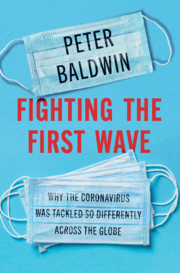Book contents
- Fighting the First Wave
- Also by Peter Baldwin
- Fighting the First Wave
- Copyright page
- Dedication
- Contents
- Introduction: One Threat, Many Responses
- Chapter 1 Science, Politics, and History
- Chapter 2 New Dogs, Old Tricks
- Chapter 3 The Politics of Prevention
- Chapter 4 What Was Done?
- Chapter 5 Why the Preventive Playing Field Was Not Level
- Chapter 6 Where and Why Science Mattered
- Chapter 7 From State to Citizen
- Chapter 8 Who Is Responsible for Our Health?
- Chapter 9 Difficult Decisions in Hard Times
- Conclusion: Public Health and Public Goods
- Acknowledgments
- Notes
- Index
Chapter 8 - Who Is Responsible for Our Health?
How Prevention Was Enforced
Published online by Cambridge University Press: 12 March 2021
- Fighting the First Wave
- Also by Peter Baldwin
- Fighting the First Wave
- Copyright page
- Dedication
- Contents
- Introduction: One Threat, Many Responses
- Chapter 1 Science, Politics, and History
- Chapter 2 New Dogs, Old Tricks
- Chapter 3 The Politics of Prevention
- Chapter 4 What Was Done?
- Chapter 5 Why the Preventive Playing Field Was Not Level
- Chapter 6 Where and Why Science Mattered
- Chapter 7 From State to Citizen
- Chapter 8 Who Is Responsible for Our Health?
- Chapter 9 Difficult Decisions in Hard Times
- Conclusion: Public Health and Public Goods
- Acknowledgments
- Notes
- Index
Summary
Public health has been given over ever more to individual citizens to vouchsafe. Democracy requires its participants to take responsibility for themselves, not be ordered about by a state. That applies primarily to chronic and lifestyle diseases, where the individual can have an effect. But epidemic diseases have not disappeared, though they are no longer as important in the industrialized world as earlier. To prevent pandemics, the state and its interventions are still needed. Because every infected person poses a threat to others, and no one wants to bear the inconvenience of preventive measures, statutory enforcement is required. This dilemma came out starkly in the coronavirus pandemic. In effect, the state held a third of humanity in house arrest during the spring of 2020. In other ways, it regulated its subjects drastically, with fines and even jail for violating pandemic restrictions. But not all violation of required behavior could be just made unlawful. To get people to wear masks, for example, passing laws and regulations was not very effective. Citizens had to buy-in to the need for masks and adopt them voluntarily. Much the same will hold for a vaccine, if and when one becomes available.
- Type
- Chapter
- Information
- Fighting the First WaveWhy the Coronavirus Was Tackled So Differently Across the Globe, pp. 197 - 222Publisher: Cambridge University PressPrint publication year: 2021

